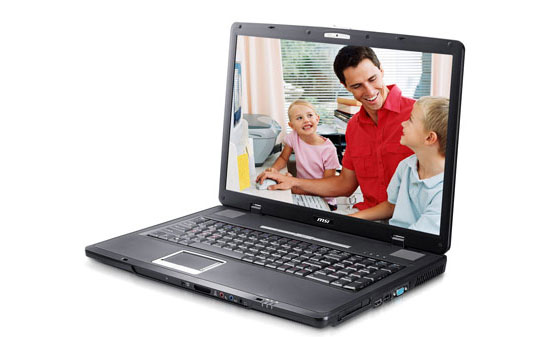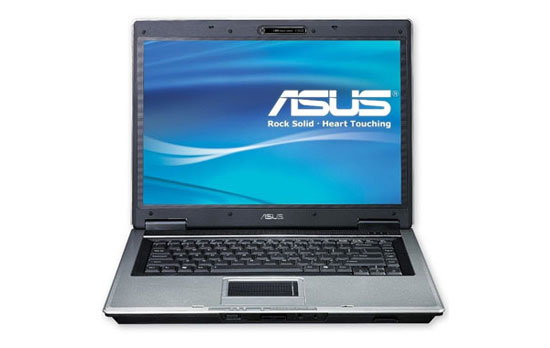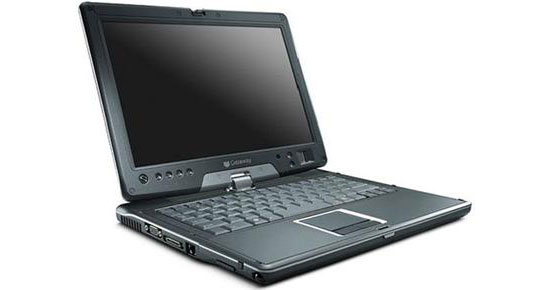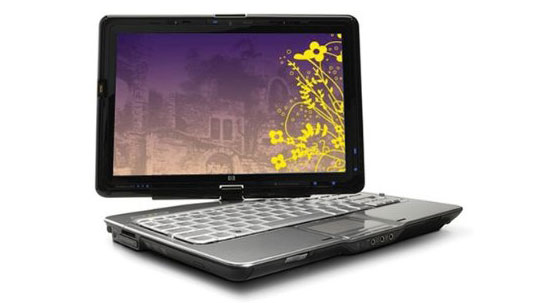Entry-Level Laptops
Entry-level laptops have a lot in common with the budget offerings, and it's basically a story of "more, more, more". You can get somewhat faster processors, more memory, larger hard drives, perhaps discrete graphics, a larger battery, and/or higher LCD resolution. You can also get less if you'd like - as in, less weight and a smaller 12.1" chassis. Sure, the subnotebooks like the Eee PC 901 are smaller, but below around 11.1" keyboard size can become a real concern and you usually get stuck with a lower LCD resolution (1024x600 or 800x480). All of this naturally comes with a higher price, but outside of graphics performance you can easily find a laptop for around $1000 that can handle just about any application. We'll look again at the major vendors to see what options are available in this price bracket.
Upgraded models on many of the budget laptops from Dell, HP, Gateway, etc. fall into the $1000 price bracket. As an example, the Gateway M Series starts at $600 with a Core 2 T5550, 2GB RAM, 160GB HDD, and 802.11G WiFi. The $1000 model bumps the CPU to a T8300 (Penryn), memory to 3GB, 250GB HDD, 802.11N WiFi, and they add in an ATI Radeon Mobility HD 2600. Dell's Inspiron 1420 and 1525 make a comeback, but with a lot more options available. If you want the 1420 and you try to keep the price close to $1000, you have a few options: upgrade the CPU to a T8300; install a Blu-ray drive; or perhaps go with a GeForce 8400M GS and 802.11N WiFi. Other combinations are possible, so what it really comes down to is choice.

If you like large notebooks, there are 17" models available that pack a lot of punch. At the low end of the price spectrum, Gateway currently has their 17" P-172X on sale for $750. This is basically the integrated graphics version of the P-6831 FX that received our Gold Editors' Choice award, only with a smaller battery and a few other minor changes. Virtually every vendor has a similar 17" chassis in the $800 to $1100 price range, and while they may be more expensive than the Gateway you can customize your component selection. If you're not willing to spend more money and you're not concerned with gaming performance, we'd suggest trying to find a 17" LCD with a 1680x1050 resolution. 1920x1200 is usually only a midrange or higher option, but you can find it in some reasonably equipped AMD Turion X2 options, like MSI's MS-171A that you can customize at vendors like AVADirect; $1000 for 1920x1200 and 2x2GB RAM with Mobility HD 2600 may just be enough to sway some users away from the Intel camp.

15.4" models are the most common notebook chassis it seems, but our one major complaint is that many come with low quality 1280x800 LCDs. There's a reason most of the $500 budget notebooks are 15.4" designs, so if you're willing to spend more money we would look more at the 17" or 14" options. There are 15.4" notebooks with higher resolution displays that are worth a look, however. Looking at Newegg, the ASUS F3SV-B3 has a 1440x900 panel, 2GB RAM, T7500 CPU, GeForce 8600M GS, and plenty of other features for just under $1000. Also at Newegg, the HP 6715b ups the ante to 1680x1050 and ships with Vista Business, but cuts back in other areas - the Turion X2 TL-60 CPU, 1GB RAM, and Radeon X1250 integrated graphics being the most noteworthy. However, you might consider other HP business options that come with a 3-year warranty if you purchase direct from their site. AVADirect sells a Compal FL92 notebook that you can get with a WSXGA+ LCD, 2GB RAM, 160GB HDD, T8100 CPU, 8600M GT, 802.11N WiFi, and a 9-cell battery for around $1100. If you don't mind the 1280x800 LCD, Gateway's M-152XL has a great feature set for only $1050 (with the current $250 instant rebate), or grab the Best Buy version M-6850 FX for $1000.

For the 13" to 14" laptops, we're again stuck with a lot of lower quality 1280x800 LCDs, which we'd just as soon avoid. It's not the end of the world, but you might want to try the laptop out in person before making a decision as some of these displays are really lousy. Ideally, we'd like LED backlighting as a minimum, but that's usually reserved for more expensive options. The Dell Inspiron 1420 remains our pick of the 14.1" $1000 notebook offerings; there may be something better out there, but we were unable to find it. The base Apple MacBook also falls into this category, priced at around $1100; given the 1GB RAM and stripped down features, however, we'd hold off on a MacBook until the midrange offerings. Somewhat surprising is that there's even a couple tablet options from Gateway starting at around $1000: the C-141X and C-142XL. The latter is amazingly well equipped for a starting price of $1100: T8300, 3GB RAM, 250GB HDD, 8-cell battery, DVDR, and a Radeon Mobility HD 2300.

The final option for the $1000 price range is a few 12.1" thin and light offerings. Most of these models fall into the midrange and higher price brackets, but there are a few affordable laptops. Newegg has the ASUS F9E-A1 $1050 (with the current $50 sale). That will get you a T5550, 2GB RAM, 160GB HDD, X3100 graphics, 6-cell battery, and a 2-year warranty. The Lenovo 3000 V200 has similar specs for about the same price (once you upgrade the warranty). HP Home has the Pavilion tx2500z tablet PC starting at $950, and the preconfigured tx2510us will set you back $1075 with a very attractive feature set: Turion X2 ZM-80 (2.1GHz), 3GB RAM, 250GB HDD, DVDR, 802.11N + Bluetooth, and integrated HD 3200 graphics. Other vendors have competing models, but we'd steer clear of the 1GB laptops when you're spending any more than $750. It's possible as always to upgrade the RAM on your own, but particularly with smaller designs this can sometimes require a decent amount of effort.
To summarize the entry-level notebook market, there are a lot more options out there than we can even begin to cover. What you need to determine is where you'd like to focus your money. You can get better display options, faster CPUs, a smaller chassis, better battery life, moderately powerful discrete graphics, more memory, larger hard drives, a longer warranty… but you can't get all of these things in any single notebook without spending more money. At best, you can pick about three or four of those areas to upgrade relative to the budget notebooks. That said, there are some really good notebooks priced at $1000 or less these days. They aren't the fastest laptops on the planet, but some of these laptops can handle everything up to and including moderate gaming. For example, if you want a mobile World of Warcraft platform, you don't need anything more than an HD 2600 or GeForce 8600M.










28 Comments
View All Comments
strikeback03 - Friday, July 11, 2008 - link
He mentioned that warranty should be something to look into, but might not have gotten into it due to the large number of options depending on vendor and specific warranty. Also some aspects of the warranty vary by person. I like the Thinkpad depot warranty - you will have a prepaid box within a day of calling, and typically will get your system back a day or two after shipping it. My sister is looking for a new laptop, and after she was without her current one for 3-4 weeks a few different times while Best Buy was doing warranty work, I figured the option to get it back quickly would be nice. Apparently she can't have stuff shipped to work though, so would have trouble with packages requiring signatures.JarredWalton - Friday, July 11, 2008 - link
I thought I made enough mention of warranties to get the point across, but in retrospect a lot of it got buried in the various sections. I've added a paragraph to the conclusion to emphasize the point, as I do feel it often gets overlooked. That's why I wrote a blog on the subject http://www.anandtech.com/weblog/showpost.aspx?i=31...">last December.EvilBob - Friday, July 11, 2008 - link
Given NVIDIA's recent announcement of overheating mobile GPUs, I'm curious whether anyone knows which M-GPUs are affected. I would guess that some of these high end machines would be the most heat-susceptible, but does anyone have any more information?pepsimax2k - Friday, July 11, 2008 - link
GeForce 8 series issues!!!was gonna post this in it's own thread but anyways... all G84 plus G86 core based 8 series GPUs may (though very likely do) all have very high failure rates. Basically everything up to and including 8600 I think, notebook and desktop; all of them.
http://www.theinquirer.net/gb/inquirer/news/2008/0...">http://www.theinquirer.net/gb/inquirer/news/2008/0...
Nothing's been confirmed yet though, and inq are known to exagerate stuff, but I'd be wary of them until knowing better.
HP have also extended warranties for a number of affected laptops (although not all, as I just got a dv9702ea not on the list but with an 8400M GS).
http://h10025.www1.hp.com/ewfrf/wc/document?lc=en&...">http://h10025.www1.hp.com/ewfrf/wc/docu...cc=us&am...
sprockkets - Sunday, July 13, 2008 - link
Interesting, as a client's 8600 based laptop died just like all those people's did. HP fixed it for free though.toonces - Friday, July 11, 2008 - link
Nice to see an article delineated into how most people buy notebooks.Timing is a little off though with the NDA lifting and Nvidia's 9800-series about to be launched in the next week or so.
No mention of Puma either? HP just released a few models with the new HD3200 that put their integrated graphics slightly higher than an 8400GS/9300GS in performance.
JarredWalton - Friday, July 11, 2008 - link
Is the HD 3200 really that fast? I thought it was more in line with 780G desktop chipset, which while faster than the other IGPs still trails modern discrete solutions. Then again, the low-end discrete mobile solutions are pretty anemic.9800M parts will be faster, but most of what was said here applies after the updates. Availability of 9800M will be the question - if it's like 8800M it will be two or three months after the launch before we see it.
toonces - Friday, July 11, 2008 - link
3DMark06 @ 1280x768dv5z (2.1GHz Turion X2 Ultra ZM-80, ATI Radeon HD 3200) = 1,599
dv6500z (2.0GHz AMD Turion 64 X2 TL-60, NVIDIA 8400m GS = 1,551
M1330 (2.0GHz T7300, NVIDIA 8400M GS 128MB) = 1,408
I know, it's only 3DMark but users of the tx2500z have reported playing Source games (DX9) on 1280x800, high settings, with steady 30FPS. Not bad for integrated I'd say.